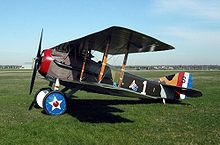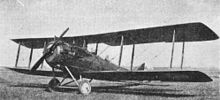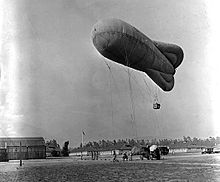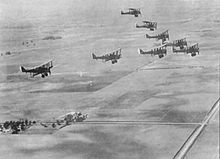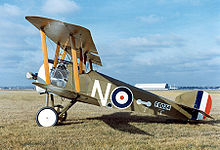- Organization of the Air Service of the American Expeditionary Force
-
The Organization of the Air Service of the American Expeditionary Force on November 11, 1918 represents its maximum strength in World War I. Units of the Air Service are listed as assigned to the order of battle for that date, which was that of the Armistice with Germany. The first air unit arrived in France in September 1917, while the final air unit reaching the front did so on November 9, 1918. Unit operations began in April 1918. At the armistice, 57,508 officers and men served in the Air Service of the AEF, 24,512 in the Zone of Advance (combat area), and 32,996 in the Services of Supply (rear areas). Of its 6,861 officers, 4,088 were on flying status and 219 were qualified observation balloon aviators. 1,724 of those on flying status and approximately 100 of the balloonists served in combat units.[1]
The Air Service, First Army was activated August 26, 1918, with Col. Benjamin Foulois named chief over Col. Billy Mitchell. The Air Service, Second Army was activated on October 12 with Col. Frank P. Lahm as chief, and the Air Service, Third Army was created immediately after the armistice to provide aviation support to the army of occupation, primarily from veteran units transferred from the First Army Air Service.
The first two air combat groups formed in the AEF were the 1st Corps Observation Group, in April 1918, and the 1st Pursuit Group at Toul. Ultimately fourteen airplane and seven balloon groups were formed. The five pursuit and two bombardment groups were organized into two wings, while the seven observation and seven balloon groups were allotted one per army and corps air service, with two flexible "observation wings" organized to coordinate the reconnaissance activities of the five corps air services.
The basic units of the air service were the squadron for powered aircraft and the company for balloons. 45 squadrons (38 of which conducted combat operations) of aircraft and 17 companies of balloons served at the front. The 20 pursuit and seven bombardment squadrons were authorized 25 aircraft (including spares) and 18 crews each by the Field Service Regulations, while the 18 observation squadrons were each authorized 24 planes and 18 crews. Balloon companies were equipped with one balloon and approximately six observers each.
Contents
Air Service of the AEF, 11 November 1918
- Chief of Air Service, AEF - Maj.Gen. Mason Patrick (Chaumont)
- Chief of Air Service, Group of Armies - Brig. Gen. William L. Mitchell
Air Service, First Army
Col. Thomas D. Milling, (Souilly)
- 1st Pursuit Group - (Rembercourt, Maj. Harold E. Hartney)
- 27th, 94th, 95th, & 147th Aero Squadrons (Spad XIII)
- 185th Aero Squadron (night pursuit) - (Sopwith F-1 Camel)
- 1st Pursuit Wing - (Chaumont-sur-Aire, Maj. Burt M. Atkinson)
- 2d Pursuit Group - (Souilly, Maj. Davenport Johnson)
- 3d Pursuit Group - (Foucaucourt, Maj. William K. Thaw II)
- 1st Day Bombardment Group - (Maulan, Maj. James L. Dunsworth)
- 11th, 20th, 166th (DH-4B) & 96th (Breguet 14 B2) Aero Squadrons
- 155th Aero Squadron (night bombardment) - (Belrain, Sopwith FE-2b)
- First Army Observation Group - (Vavincourt, Capt. Harry T. Wood)
- 9th Aero Squadron (night reconnaissance) - (DH-4B, FE-2b)
- 24th Aero Squadron - (Salmson 2.A2)
- 91st Aero Squadrons (Salmson 2.A2)
- 186th Aero Squadron (Lemmes, Salmson 2.A2)
- First Army Balloon Group - (Maj. John Paegelow)
-
- 11th (Fontaines) & 43d (Fossé) Balloon Companies
-
- Corps Observation Wing - (Rampont, Maj. Melvin A. Hall)
-
- Air Service, I Corps - (Chéhéry, Capt. Oliver P. Echols)
- 1st Corps Observation Group - (Julvécourt, Capt. Arthur J. Coyle)
- 1st Aero Squadron - (Salmson 2.A2)
- 12th Aero Squadron - (Salmson 2.A2)
- 50th Aero Squadron - (Clermont-en-Argonne, DH-4B)
- Escadrille Br.211, Aéronautique Militaire - (Clermont-en-Argonne, Breguet 14)
- 1st Corps Balloon Group - (Chéhéry)
-
- 1st (Auzéville), 2d (Les Petites-Armoises), & 5th (La Besace) Balloon Companies
-
-
- Air Service, III Corps - (Dun-sur-Meuse, Maj. Joseph C. Morrow)
- 3d Corps Observation Group - (Bethelainville, Capt. Kenneth P. Littauer)
- 88th Aero Squadron (Dorand AR, Sopworth 1, Salmson 2.A2)
- 90th Aero Squadrons (Sopworth 1, Salmson 2.A2, Spad XI)
- Escadrilles Br.219 & Br.229, Aéronautique Militaire - (Courcelles-en-Aire, Breguet 14)
- 3d Corps Balloon Group - (Dun-sur-Meuse)
-
- 3d (Belrupt), 4th (Vilosnes-sur-Meuse), 9th (Consenvoye), & 42d (Villers-devant-Dun) Balloon Companies
-
- 5th Corps Observation Group - (Parois, Capt. Stephen H. Noyes)
- 99th Aero Squadron (Salmson 2.A2)
- 104th Aero Squadron (Salmson 2.A2)
- Escadrilles Br.214 & Spa.215, Aéronautique Militaire - (Parois, Breguet 14 and Spad XIII)
- 5th Corps Balloon Group - (Nouart, Capt. Alvin C. Rois)
-
- 6th (Brabant-sur-Meuse), 7th (Tailly), 8th (Nouart), & 12th (Buzancy) Balloon Companies
-
Air Service, Second Army
Col. Frank P. Lahm, (Toul)
- 4th Pursuit Group - (Toul, Maj. Charles J. Biddle)
- 17th, 25th, 141st, & 148th Aero Squadrons (mostly Spad XIII, with S.E.5a for 25th Aero Squadron)
- 5th Pursuit Group - (Lay-Saint-Remy, Capt. Dudley L. Hill)
- 41st, 138th, & 638th Aero Squadrons (forming)
- 2nd Day Bombardment Group - (Ourches, Maj. George E. A. Reinberg)
- 100th Aero Squadron & 163d Aero Squadrons (DH-4B)
- Balloons Wing - (Toul, Maj. John H. Jouett, Balloon Officer, Second Army)
-
-
- (Six companies en route to front)
- 20 and 52 Balloon Companies, Aéronautique Militaire
-
- Second Army Observation Wing - (Toul, Lt.Col. John H. Reynolds)
- Second Army Observation Group - (Major C. Delaney, attached from French Third Army)
- Escadrilles Sal.28, Spa.47, and Spa.277, Aéronautique Militaire - (Saint-Mihiel, Salmson 2 and Spad XIII)
- Air Service, IV Corps - (Toul, Maj. Harry B. Anderson)
- 4th Corps Observation Group - (Toul)
- 8th Aero Squadron - (Salmson 2.A2)
- 135th Aero Squadron - (DH-4B)
- 168th Aero Squadron - (DH-4B)
- 255th & 278th Aero Squadrons (designated for VII Corps) - (DH-4B)
- 4th Corps Balloon Group
-
- 15th, 18th, & 69th Balloon Companies
-
-
- Air Service, VI Corps - (Nancy, Maj. Joseph T. McNarney)
- 6th Corps Observation Group - (Saizerais, Capt. John G. Winant)
- 8th Aero Squadron - (Salmson 2.A2)
- 354th Aero Squadron - (DH-4B)
- 6th Corps Balloon Group
-
- 10th Balloon Company
-
Air Service, Third Army
Promptly after the armistice, the AEF formed the Third United States Army to march immediately into Germany while the remainder of the army demobilized. Brig. Gen. Mitchell was appointed to command the Air Service, Third Army, on November 14, 1918.[2] Gen. Mitchell was replaced in January as commander of the Third Army Air Service by Col. Harold Fowler, a combat veteran of the Royal Flying Corps and former commander of the American 17th Pursuit Squadron.
The most veteran units of the Air Service were selected to form the new Air Service. A pursuit unit, the 94th Aero Squadron; a day bombardment squadron, the 166th; and four observation squadrons (1st, 12th, 88th, and 9th Night) were initially assigned.[3]
On April 15, 1919, the Second Army Air Service in France closed down. Its former air units were transferred to the Third Army Air Service in Germany, which at its maximum consisted of the:
- 5th Pursuit Group (Coblenz)
- 41st, 138th, 141st, and 605th Aero Squadrons (Sopwith F-1 Camel)
- 3rd Corps Observation Group (Weißenthurm)
- 1st, 24th, and 258th Aero Squadrons (Salmson 2.A2)
- 4th Corps Observation Group (Sinzig)
- 85th and 278th Aero Squadrons (Salmson 2.A2)
- 7th Corps Observation Group (Trier)
- 9th Aero Squadron (Night observation, DH-4B)
- 88th and 186th Aero Squadrons (Salmson 2.A2)
Notes
- ^ Thomas, Capt. Shipley (1920). The History of the AEF. George H. Doran Co., pp. 385-386. 574 other members of the Air Service were with the British Expeditionary Force and 8 with the French armies.
- ^ Cooke, James J. (1996). The U.S. Air Service in the Great War, 1917-1919. Preager Press. ISBN 0275948625. P. 204.
- ^ Cooke (1996), p. 208.
Bibliography (Sources)
- Order of battle and commanders, 'Maurer Maurer (ed.) (1978). The U.S. Air Service in World War I, Volume I: The Final Report and A Tactical History, pp. 391–392;
- Locations and aircraft, Maurer Maurer Combat squadrons of the Air Force, World War II, USAF Historical Study 82, under individual unit entries
Categories:- World War I aviation
- United States Army
- World War I orders of battle
Wikimedia Foundation. 2010.

